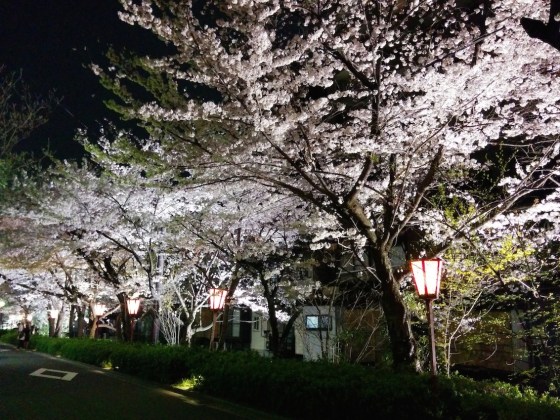
Cherry blossoms, Kyoto
To put it simply, we loved Japan. 3-weeks was barely enough time. A beautiful country with a rich and truly unique culture. We loved how efficiently everything functions, like the train system that runs so punctually that it puts every other country’s train system to shame. We loved how incredibly polite and hospitable everyone is, such as the times we would ask someone for directions and have them personally accompany us all the way to our destination. We loved how clean everything is, even though you struggle to find a rubbish bin. We loved Japan’s quirkiness, such as the crazy cafes where young waitresses dressed up as french maids “meow” at you, or the cosplay fashion where young adults dress up like comic book characters. And of course, we loved the food. More on that later.
Tokyo: random Karaoke
Our first stop in Japan was Tokyo, where we stayed for a week. Tokyo has that incredible buzz of a metropolis mixed with everything great about Japanese culture from cleanliness, to efficiency, to politeness and of course quirkiness. It’s a place we want to go back to again and again, as we get the impression we would never grow bored of it.
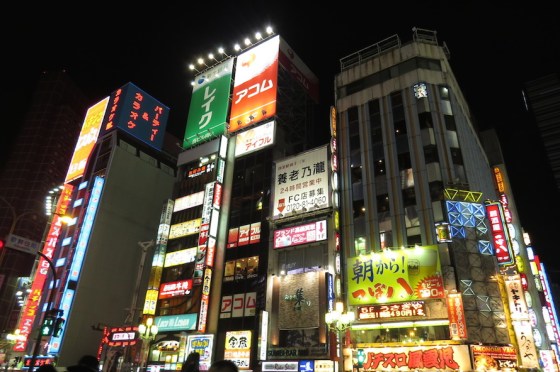
Lights of Shinjuku, Tokyo

Catching up with friends: Dinner with Masa

Catching up with friends: Dinner with Wouter

Catching up with friends: Dinner with Wouter

Catching up with friends: Dinner with Momo and Jen

Catching up with friends: Dinner with Hide

“Meow!” at the Maid Cafe, Tokyo

Tokyo fashion

Tokyo fashion

Tokyo fashion

Tsukiji Fish Market, Tokyo

Tsukiji Fish Market, Tokyo

Tsukiji Fish Market, Tokyo

Tsukiji Fish Market, Tokyo

Tsukiji Fish Market, Tokyo

Tsukiji Fish Market, Tokyo

Tsukiji Fish Market, Tokyo

Tsukiji Fish Market, Tokyo

Tsukiji Fish Market, Tokyo

Tsukiji Fish Market, Tokyo

Tsukiji Fish Market, Tokyo

Sushi at Tsukiji Fish Market, Tokyo

Sushi at Tsukiji Fish Market, Tokyo

Macha tea ceremony, Tokyo

Macha tea ceremony, Tokyo

Robot restaurant, Tokyo

Robot restaurant, Tokyo

Robot restaurant, Tokyo

Shinkansen (bullet train), Tokyo
One of the highlights of our week in Tokyo was not really planned. On our second evening we found ourselves feeling a little hungry. It was a bit early for dinner, so we decided to just have a snack at a yakitori (chicken skewers) joint. We’d been told that a good place to try yakitori is Omoide Yokocho (also known as “piss alley” for some reason) in Shinkuju so we thought we’d give it a try. The narrow alley is littered with small restaurants, with very little written in English. Unsure how to choose, we figured to go after the joint that seemed most crowded with Japanese people and found this great place where no English was spoken. Through a bunch of pointing we were able to order some skewers of a whole bunch of different pig parts. I’m usually not a big fan of innards or tongue, but this stuff was delicious. So delicious that our quick snack turned into a full on dinner, as we tried all sorts of meats that I’m not even sure of and drank lots of beer.

Omoide Yokocho (“piss alley”)
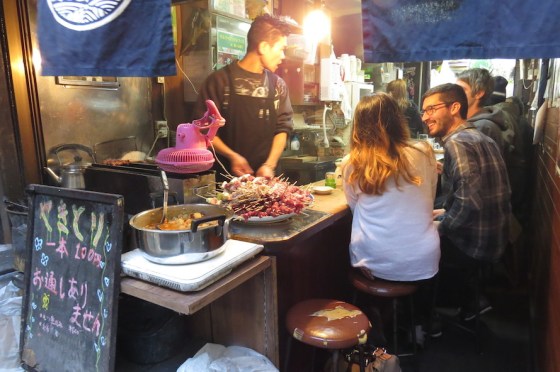
Omoide Yokocho (“piss alley”)

Our yakitori joint, Omoide Yokocho (“piss alley”)

First course: pig intestines (I think…)

Second course: beef tongue (yum!)


Skewers of all different parts of the pig
A couple of hours later, we stumbled out of the joint and it was now dark. Not yet ready to go home we looked for a bar to have a drink or two before calling it a night. Just down the road from Omoide Yokocho is another place that was recommended to us: Golden Gai. Golden Gai is a neighbourhood full of tiny bars that barely seat 6 people. Each has its own kind of theme. Again we looked for a bar that seemed to be busy and found one that could just squeeze us in. The great thing about these kinds of bars is that they’re intimate so that everyone talks with each other. While not a lot of English was spoken, the guy next to us tried his best. After a couple of drinks, two more guys came in the bar, one from Japan and one from England. We started chatting together and before long we were invited to come and sing karaoke with them. Why not?! So what we expected to be a casual and quiet Sunday evening, ended in late night beers and karaoke. Only in Japan.

Our bar in Golden Gai, Tokyo
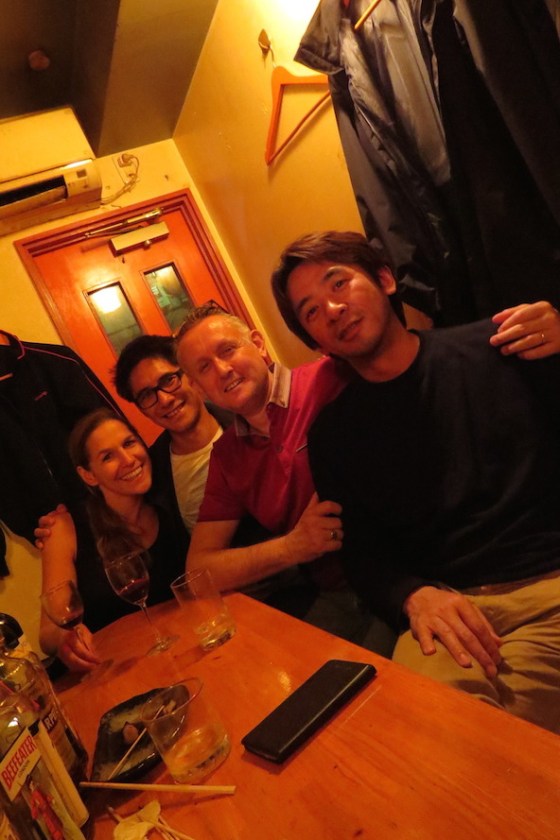
New friends (Kevin and Ken) we met at the bar

Karoake with our new friends, Kevin and Ken
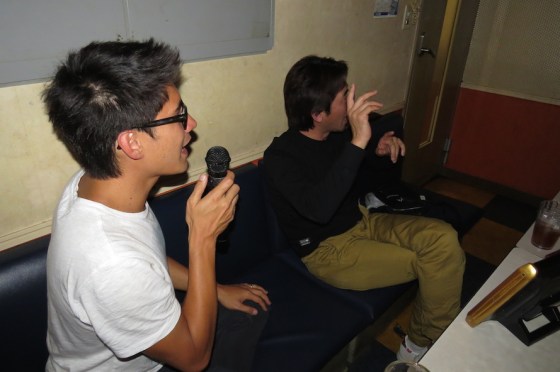
Karoake with our new friends, Kevin and Ken
Mt Takao: the “oh so cute” Japanese school children
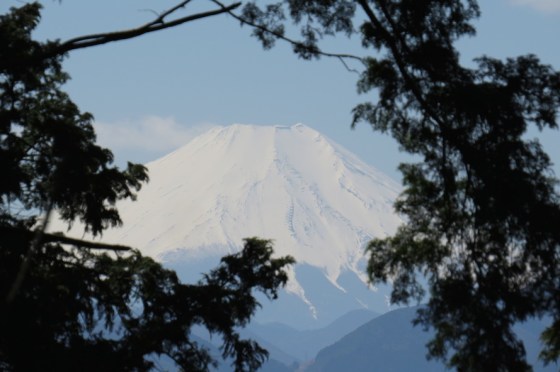
View of Mt. Fuji from Mt. Takao, Japan
Having budgeted 6-days in Tokyo, we figured that afforded enough time to make a day trip out of the city to get a bit closer to nature. After some asking around, we heard that Mount Takao would be a good choice since the surrounding nature is beautiful, it has a great view of Mt. Fuji, and it is less than an hour away by train. While all of that turned out to be true, the actual highlight of our day trip to Mt. Takao was observing a group of adorable 6 year old Japanese school kids on excursion.
The whole scene could not be more different to what a school lunch break was like when I was 6 years old, where we’d sit on the ground and eat a sandwich with our grubby fingers. Instead, each of them had their own picnic mats that they took out of their backpacks and carefully laid out in front of them. Before sitting on these picnic mats, they took of their shoes. Before beginning to eat, they took out a rolled up wet cloth (that had its own special container in their backpack) and diligently cleaned their hands. And of course, the food in their lunch box was wonderful. Each child had their own bento box that had clearly been homemade. We saw skewers of edamame; rice balls with smiley faces; nori rolls, just to name a few. Watching these children reminded us of everything that is so wonderful about Japanese culture.
While we didn’t want to be those kinds of tourists who secretly take photos of other people, we couldn’t help ourselves…

Picnic mat out, shoes off, hands cleaned

Whats for lunch?
Naoshima: bumping into friends in the middle of nowhere
For our first stop after Tokyo, we made our way to the tiny island of Naoshima for a day and a night. Over the last 10 years, Naoshima has established itself as a bit of an art lovers destination with its several art galleries and installations scattered across the island. That said, the place is tiny with barely 3,000 people. So you can imagine our surprise when we bumped into our friends Alan Au and Kian Lee from Sydney, who happened to be there on their honeymoon!

“Look who we bumped into?!” with Alan Au and Kian Lee in Naoshima
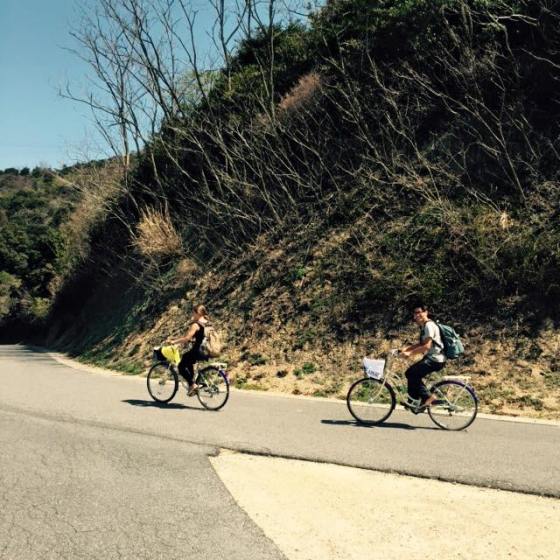
Biking around Naoshima

Naoshima art island, Japan

Naoshima art island, Japan

Naoshima art island, Japan

Naoshima art island, Japan

Naoshima art island, Japan

Naoshima art island, Japan
Hiroshima: hula-hooping under a cherry blossom tree.
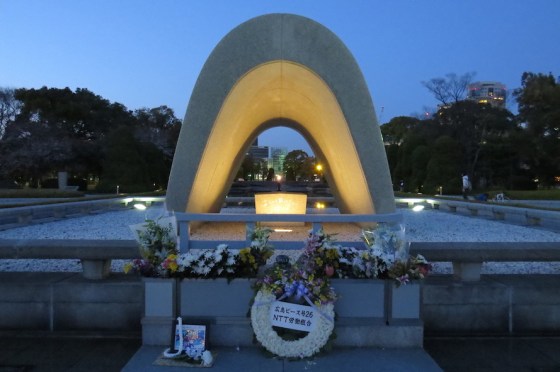
Peace memorial park, Hiroshima
By the time we arrived in Hiroshima, the cherry blossoms were just starting to bloom. Now, I’ll admit that before we came to Japan I was skeptical as to why there was so much fuss around cherry blossom season. It’s just a flower blooming after all. However, after having experienced it I can appreciate why the occasion is so beloved. First of all, cherry blossom trees grow almost everywhere in Japan and so when they hit full bloom the colours of the trees transform the streets and parks. Second, the cherry blossom trees themselves don’t have any leaves at this stage so all you see is the beautiful white/pink blower buds which almost looks like snow. It’s like a winter wonderland in spring. Third, the tradition of having picnics under cherry blossom trees create a festive atmosphere. And last, the fact that the full bloom barely lasts more than a few days creates a feeling of preciousness to the occasion.

Cherry blossoms, Hiroshima

Cherry blossoms, Hiroshima

Cherry blossoms, Hiroshima

Cherry blossoms, Hiroshima
One of our favourite cherry blossom experiences was in Hiroshima at Hijiyama park. We went to the park looking to find a quiet patch of grass where we could practice hula hooping for a while. We ended up finding this beautiful spot right under a cherry blossom tree where we plugged in our headphones and hooped the afternoon away. It was a serene experience. The perfect weather; the state of flow we got into while hooping listening to music; the beauty of the cherry blossom tree. Just amazing.

Hooping under cherry blossoms in Hijiyama park, Hiroshima

Hooping under cherry blossoms in Hijiyama park, Hiroshima

Hooping under cherry blossoms in Hijiyama park, Hiroshima

Hooping under cherry blossoms in Hijiyama park, Hiroshima

Hooping under cherry blossoms in Hijiyama park, Hiroshima

Hooping under cherry blossoms in Hijiyama park, Hiroshima

Hooping under cherry blossoms in Hijiyama park, Hiroshima

Hooping under cherry blossoms in Hijiyama park, Hiroshima
Miyajima: our secret night time cherry blossom spot

Floating shrine, Miyajima

Floating shrine, Miyajima

Floating shrine, Miyajima

Floating shrine, Miyajima
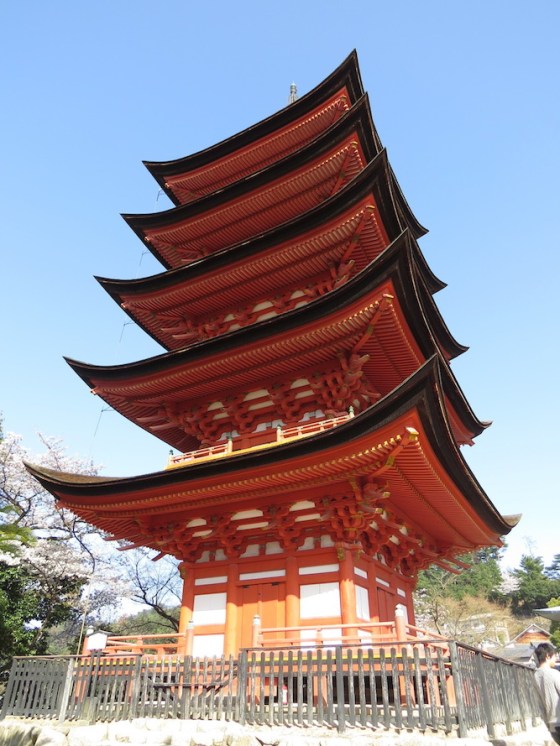
Five story pagoda, Miyajima

Temple statues, Miyajima

Temple statues, Miyajima
Another one of my favourite cherry blossom experiences was at Miyajima, nearby from Hiroshima. Christine and I were taking a stroll in the evening after dinner, and took a detour away from the main strip up into the nearby hills. It was there we stumbled across this tiny park, full of cherry blossom trees that were illuminated at night with pink lanterns. Under one of the trees a group of young Japanese adults were having an evening picnic. From this spot you could look through the lit up cherry blossoms out onto the waters of Miyajima.

Evening cherry blossom viewing, Miyajima

Night time cherry blossom viewing, Miyajima
Kyoto: Discovering Dashi
After a few days spent between Naoshima, Hiroshima and Miyajima, we arrived in Kyoto where we stayed for 4 days. We had decided to spend a good amount of time in Kyoto because it is the cultural capital of Japan and we’d also been told it was the best place to view cherry blossoms in the country.

Fushimi Inari shrine, Kyoto

Fushimi Inari shrine, Kyoto
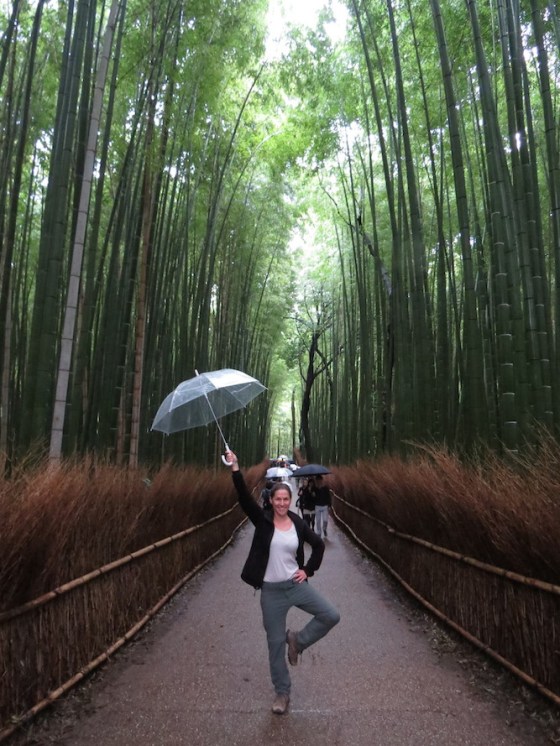
Bamboo grove, Kyoto

Tenryuji Temple, Kyoto

Sake tasting with our Sake Tour, Kyoto

Sake brewery visit with our Sake Tour, Kyoto

Sake tasting with our Sake Tour, Kyoto

Sake shop visit with our Sake Tour, Kyoto

Ginkakuji Zen Temple, Kyoto

Mt. Fuji sand sculpture at Ginkakuji Zen Temple, Kyoto

Geisha tea ceremony, Kyoto

Dinner with Pato and Kenny, Kyoto
We had amazing food experiences throughout Japan: yakitori; gyozas; ramen; udon; soba; tonkatsu; miso; tempura; sushi; just to name a few! In Kyoto, we got a little closer to understanding why Japanese food is so great, taking a cooking class with Cooking Sun. We cooked a bunch of different dishes, but the biggest revelation was learning about Dashi. Dashi is a broth that is the foundation of many Japanese dishes from miso soup to the accompanying broth we had with many fish dishes to the sauce we dipped our tempura in. What I love about Dashi is that unlike other European style broths made with bones, it is so quick and easy to prepare. Just kombu seaweed and bonito (dried fish) flakes. Like other broths, the purpose of Dashi is to bring out the umami flavour in foods which the Japanese are masters of. Since doing the cooking class we’ve since read about the rich history of Dashi along with the many health benefits. And we’ve even had a chance to experiment with making Dashi and other variations at home, even using it as a base in European dishes we cook (worked very well!).

Dashi ingredients: dried shiitake mushrooms, kombu seaweed and bonito

Making our first ever dashi!

Cooking class, Kyoto

With Alex and Susan at the cooking class, Kyoto
Kobe: Kobe in Kobe
On the topic of great food experiences, one of the absolute highlights was eating Kobe beef in Kobe. After some digging around we’d heard that Kobe Ishidaya would be a great introduction to the wonderful world of Kobe beef. Ishidaya is a Teppan restaurant where the chef cooks in front of you (no, they don’t throw food at you like at those cheesy Benihana restaurants). Christine and I both ordered the set menu, with one of us taking the very highest grade Kobe (most marbled) and the other taking the next grade down (slightly less marbled) to have some point of comparison. Both cuts of meat were incredible. Melt in your mouth incredible. The taste was like nothing I’d ever experienced before. It was probably more akin to fatty tuna than steak. As I recall this experience I find my mouth watering…

Kobe beef, Kobe

Kobe beef cooked on the teppan, Kobe

Delicious Kobe beef, Kobe
Kinosaki Onsen: our glimpse into traditional Japan
Almost everyone, who we asked for tips on Japan, said we had to experience a traditional Japanese onsen (hot spring), many recommending the small onsen town of Kinosaki Onsen as the place to go. We loved it. The whole experience was so calming and another wonderful example of everything we love about Japan.

Getting dressed in the yukata, Kinosaki Onsen

Dressed in yukata, Kinosaki Onsen
Kinosaki Onsen is a tiny town with barely more than a few Ryokans (Japanese traditional accommodation) and the seven public bath houses built upon the natural hot springs. It is set in beautiful hilly countryside, not far away from the northern coast of the main island of Japan (Honshu). The majority of the architecture is old style Japan. Most of the guests in the town are dressed in the traditional Yukatas (like a basic version of the Kimono) as they go from bathhouse to bathhouse.

Streets of Kinosaki Onsen

Walking around in Kinosaki Onsen

Cherry blossoms in Kinosaki Onsen
The Ryokan experience is wonderful in itself. The room you stay in is very basic. Just tatami mats and a low table with cushions. A Kaiseki (multi-course) dinner was served in the room. It was quite serene to sit in our Yukata robes and eat this wonderful meal together. And then afterwards, the staff cleared everything away making space for our futons for us to sleep on.

Dinner in our ryokan, Kinosaki Onsen

Breakfast at our ryokan, Kinosaki Onsen

Preparing the futons in our ryokan, Kinosaki Onsen
Tokyo (again): farewell sushi
After almost 3-weeks in Japan, we found ourselves back in Tokyo for our final two nights before we flew out. A little while ago, Christine and I had watched the documentary of a Japanese sushi chef, “Jiro dreams of sushi“, with awe and fascination. While it would have been cool to actually eat at his restaurant (which was out of the question since it’s booked out months in advance) we did the next best thing and found an equally impressive high end sushi restaurant for our last night in Tokyo, Sushi Kanesaka. To say it was the best sushi we’d ever eaten would be an understatement. Every piece we ate was an absolute delight. The perfect end to a fantastic Japan experience.

Sushi Kanesaka, Tokyo

Sushi Kanesaka, Tokyo

Sushi Kanesaka, Tokyo

Sushi Kanesaka, Tokyo

Sushi Kanesaka, Tokyo

Sushi Kanesaka, Tokyo

Sushi Kanesaka, Tokyo

Sushi Kanesaka, Tokyo

Sushi Kanesaka, Tokyo

Sushi Kanesaka, Tokyo

Sushi Kanesaka, Tokyo

Sushi Kanesaka, Tokyo

Sushi Kanesaka, Tokyo



















































































































